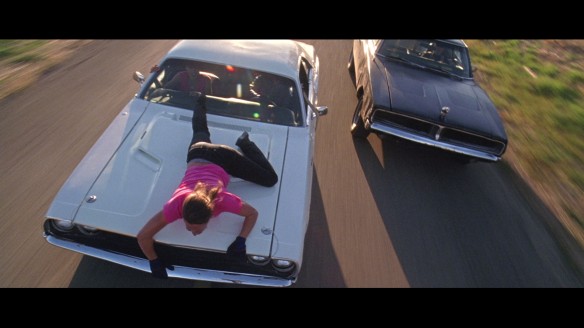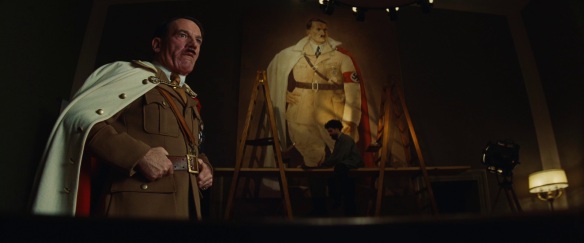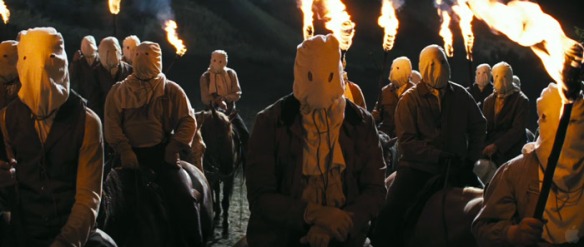Consider the panache with which Quentin Tarantino arrived into American culture. With the one-two punch of structurally revolutionary crime thrillers Reservoir Dogs and Pulp Fiction, Tarantino set himself apart in endless ways: with his incredibly funny, elaborate dialogue, his French New Wave-meets-Looney Tunes aesthetic, shocking bursts of violence, and especially his gift for repurposing ‘70s grindhouse-movie sleaze into something a little more palatable for America’s critical elite. At age 31, he more-or-less grabbed early-’90s independent cinema by the balls. It was the best thing that ever happened to him — two decades later, he’s still riding on the momentum picked up back then — but it’s had something of an unexpected effect.
See, when one hears the name “Tarantino”, what comes to mind is exactly what I’ve mentioned: dialogue, violence, humor, et cetera et cetera. But what often goes unspoken in endless praise for Tarantino is that he’s become an incredibly humane artist, and has evolved from sophisticated showman to an unexpected champion of the underdogs of American culture and history. One of the reasons I’m so convinced of his greatness is that he’s developed this attitude while continuing to improve all that made him so appealing in the first place.
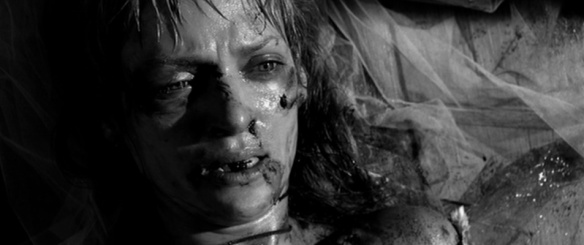
Uma Thurman’s “Bride” starts out bloodied, beaten and objectified at the beginning of KILL BILL (2003/2004).
His references to genre (slasher, western, men-on-a-mission, martial arts) are only becoming more obscure, his naughty-boy, smart-ass dialogue is only becoming more outrageous, and his violent set-pieces are now comparable to the masterful action auteurs (Sam Peckinpah, Jackie Chan) that directly inspired him. Witness Kill Bill, Vol. 1’s near-balletic climactic fight, in which lead actress Uma Thurman lays waste to 88 (!) male (!!) swordsmen. Consider also Django Unchained’s infamous final shootout, in which Jamie Foxx’s uprising against dumb-fuck slavers genuinely transcends its roots as mere screen violence and becomes something closer to visceral, blood-soaked opera.
It could be argued that he’s gotten too good at this, to the point that audiences are missing the point as to why it’s being done — to confront the sins of America itself, and provide a sort of cathartic release against those sins.
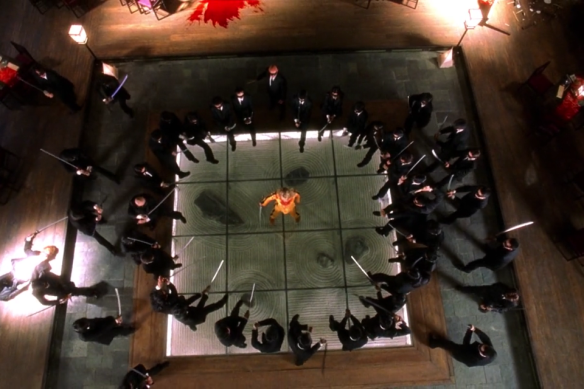
The Bride at the peak of her combative powers, ready to take on the Japanese mafia in KILL BILL (2003/2004).
Kill Bill may be the greatest pivot point in his body of work — it was here that he picked up both his chapter-divided structure and strong fixation on cultural revenge. The lead character, known simply as the Bride, is a woman whose wedding rehearsal is ambushed, leaving her in a coma for years — during which she is stripped of her infant daughter, raped in her sleep, and nearly assassinated by the gang she once belonged to. She wakes up one day and begins to take revenge on all who wronged her.
It’s at once Tarantino’s most expansive film — around four and a half hours, front-to-back, yet probably his most focused. Rather than tackle entire racial/cultural groups (as he would later), he allows an outrageously defiled woman to reclaim her dignity and daughter.
He continued much at the same rate for 2007’s Death Proof, likely his most under-seen movie, and quite unfortunately so. It’s the story of psychotic serial-killer ‘Stuntman Mike’, whose main trade is luring young women into his ‘death-proof’ stunt car and creatively offing them.
Even for such a film with such sleazy qualities — frequent close-ups of womens’ feet, incredibly sexualized dialogue, an extended lap-dance sequence — when a group of young women take revenge on Stuntman Mike, it’s immensely satisfying all the same. The key image of the film is in the midst of the famous car-chase — where Stuntman Mike stops chasing a car full of women and instead, the women begin chasing HIM. It’s where victimization turns into empowerment, buried within one of the greatest car-chase sequences of all time. It’s great stuff.
But with 2009’s Inglourious Basterds, Tarantino took his biggest leap forward in artistic maturity and thematic complexity. It’s a revenge movie (noticing a pattern…?) but one accomplished all too cleverly — imagining an alternate reality in which Hitler and much of his Third Reich are violently gunned down in a movie theater by a group of bloodthirsty Jewish-American troops. In essence, this distills his career’s entire thesis statement into one solitary sequence — proclaiming the power of cinema to correct cultural evils and prejudices. This decision to rewrite history drew lots of controversy — by design, it should be noted — but it’s total genius in my book; subtly implying that artistic freedom is a higher end to achieve than historical reverence. Why can’t fictional characters kill Hitler in a fictional movie theater? Why does adhering to history demonstrate any sort of higher ethical value than straying from it?
By the release of his most recent masterpiece, Django Unchained, popular consciousness began to catch up with the subliminal agenda Tarantino’s set out on for the last decade. (The film, probably his best-received since Pulp Fiction, took home two Oscars for acting and writing.) But this may be his first instance of copy-and-pasting his own themes from film to film. While it’s an incredibly impactful work and certainly among the best American films of its year, depicting the protracted payback of a slave against southern slave-owners, there’s not nearly as much value beneath the bloodshed as the films that came before it. Each new Tarantino film presents a new interpretation of revenge — whether it’s revenge as inversion of genre-film trope, revenge as cathartic release against millenniums of oppressive white male presence, or revenge as example of transcendent power of art. Rather than dig up anything new, Django just sorta cobbles all of these previous philosophies together. It works but it’s not new.
Where he will go next, no one really knows. There’s been whisperings of more Kill Bill offerings, as well as a script entitled Killer Crow, in which black WWII troops band together and slaughter their oppressive white ‘allies’. But for someone with such an incredible sense of cinematic history and context, Tarantino likely knows all too well what happens when directors repeat themselves far too much. With his work, he’s made an incredible collective statement on the value of recognizing cultural misdeeds and punishing those responsible. But if he wants to exit the conversation for “best directors of the decade” and enter one more akin to “greatest artists of the last half-century”, the dude may need to start playing a new song.

